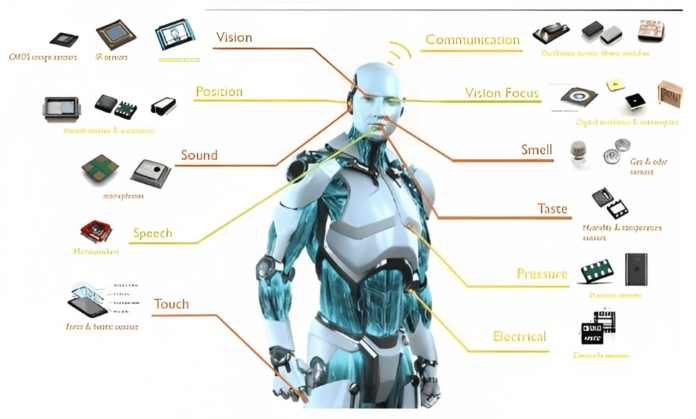Robotics is rapidly transforming industries worldwide. From production lines to healthcare settings, robots are now capable of executing intricate tasks with unmatched precision, speed, and flexibility. This leap in performance is largely driven by advanced sensors that enable robots to sense and interpret their surroundings. As industries continue to embrace automation, the market for robot sensors is expected to surpass a $5 billion valuation by 2032.
Key Drivers of Expansion
1. Industrial Automation and Smart Manufacturing
The push toward Industry 4.0 is accelerating the adoption of robotics in manufacturing and production. In these environments, sensors are crucial for helping robots identify objects, prevent collisions, and perform tasks with high accuracy. Sectors like automotive, electronics, and aerospace are at the forefront of this trend, significantly boosting sensor demand.
2. Broadening Applications Across Various Sectors
Robot sensors are not confined to manufacturing alone; they are revolutionizing multiple industries:
- Healthcare: They provide essential real-time feedback during robotic-assisted surgeries and patient monitoring.
- Agriculture: Equipped with environmental and vision sensors, robots can monitor crops, analyze soil, and manage pests effectively.
- Logistics: Autonomous delivery robots and automated warehouses depend on sensors for navigation and managing inventories.
3. Advances in Sensor Technologies
Ongoing improvements in sensor design—such as LiDAR, ultrasonic, and tactile sensors—are making them more compact, efficient, and affordable. This evolution enhances robots’ abilities in complex applications, ranging from self-driving vehicles to humanoid robots.
4. Growing Demand for Collaborative Robots (Cobots)
Cobots, which work in tandem with human workers, rely on sophisticated sensor systems to ensure safety and efficiency. These sensors detect human presence and adjust operations accordingly, driving the need for more advanced solutions, especially in small- and medium-sized enterprises.
Emerging Trends in the Market
1. Integration with Artificial Intelligence (AI)
The combination of AI and sensor technology is transforming robot capabilities. AI enables sensors to analyze vast amounts of data, recognize patterns, and make independent decisions, significantly enhancing robots’ ability to operate in dynamic environments.
2. Emphasis on Sustainability
With sustainability becoming increasingly important, industries are leveraging robotics to reduce waste and optimize energy use. Sensors contribute by ensuring robots run efficiently, which helps companies meet environmental goals.
3. Rise of Edge Computing
Edge computing allows sensors to process data locally instead of relying on remote servers, reducing response times and improving real-time decision-making. This is particularly valuable for applications like autonomous vehicles and medical robotics.
4. Increased Investment in Research and Development
Heavy investment from leading companies and research institutions is driving the development of next-generation sensors. Innovations like bio-inspired sensors, which replicate human senses such as touch and vision, promise to unlock new possibilities in robotics.
Challenges and Opportunities
While the robot sensor market offers vast potential, it also faces hurdles. High initial costs and the technical complexity of integrating sensors can slow adoption, especially for smaller companies. Additionally, issues related to data security and privacy in robotic systems may pose challenges. However, these obstacles also create openings for companies that can deliver cost-effective, user-friendly, and secure sensor solutions. Emerging markets in regions like Asia-Pacific, Latin America, and Africa further present significant opportunities for growth through increased automation and infrastructure investments.
Regional Overview
North America:
The region leads in the adoption of robotics, thanks to strong advancements in technology and high usage across sectors such as automotive, healthcare, and defense.
Europe:
Supported by initiatives that promote smart manufacturing and Industry 4.0, Europe is experiencing steady growth, with nations like Germany, France, and the UK taking significant strides in robotics integration.
Asia-Pacific:
Expected to witness the fastest growth, the Asia-Pacific region benefits from rapid industrialization, substantial investments in automation, and a robust presence of major electronics and automotive companies, with China, Japan, and South Korea being key players.
Looking Forward
The landscape of robot sensors is on the brink of a major evolution. Driven by continuous technological advancements, the growing reliance on automation, and expanding applications across diverse sectors, the market is set to achieve remarkable milestones in the next decade. Industry stakeholders must prioritize innovation, strategic collaboration, and overcoming current challenges to fully harness the potential of this dynamic field.
In essence, as robotics reshapes how industries function and enhances our quality of life, the significance of sensors in delivering precision and intelligence cannot be overstated. The anticipated $5 billion market by 2032 represents not just a financial milestone, but a critical turning point in the evolution of robotic technology.





